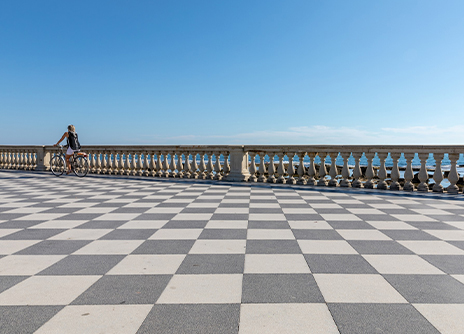
October 28, 2025
Choosing outdoor tiles for a patio, poolside, driveway, or terrace can be tricky. Many homeowners buy glossy, indoor-style tiles for outside areas (they look great… until the first monsoon makes them slippery). Others forget that parking zones need tougher tiles that can take tyre load, oil drips, and dust. And spaces near a pool or garden tap need non slip outdoor tiles, not just “matt finish”. With a little planning, you can get surfaces that are safe, durable, and easy to clean—without losing style.
Outside areas face sun, rain, mud, and temperature swings. That’s why outdoor floor tiles are usually denser, lower in porosity, and more textured than indoor tiles. Prioritise strength and grip first; looks come next.
Where they work best:
Driveways and parking: pick abrasion-resistant tiles with a grippy texture.
Patios, terraces, balconies: choose UV-stable colours and textures that hide dust.
Poolside and garden hose areas: anti-skid finishes are essential.
Steps and entries: structured surfaces keep you steady in rain.
Material options:
Porcelain/vitrified: very low water absorption and high strength—great for most outdoor floors.
Ceramic: good for outdoor wall tiles and light-use floors (check suitability).
Natural stone: rich look, but needs sealing and more care.
Somany’s Durastone range is built for these demands, pairing robust bodies with outdoor-friendly textures and a thicker profile—ranging from 10mm to 16mm—ideal for monsoon-heavy regions and homes with regular parking.
For parking bays, forecourts, and walkways, smaller formats like 300×300 mm make slopes easier and simplify future repairs.
Techstone Bronze (600×600 mm): sturdy, stable, and anti-skid—ideal as outdoor parking tiles and for high-traffic paths. Think of the texture like tyre tread: shallow grooves that quietly hold the ground in wet weather.
Geostone Grey Dark (600×600 mm): a calm, neutral option that pairs well with plants and metal or wooden outdoor furniture. The structured finish handles mud, chappals, and daily mopping without fuss.
Site tips for floors:
Avoid glossy tiles in parking. Pick structured matt or “grit-feel” finishes.
Plan a gentle 1:60–1:80 slope towards a drain.
Use polymer-modified grout to reduce hairline cracks.
In hot zones, lighter tones reduce heat build-up underfoot.
Any area that often gets wet needs extra traction.
Champion Nero (600×600 mm): a contemporary non slip outdoor tiles option for open courtyards, pool decks, and wide steps. The larger format means fewer joints and a clean look.
Quick checklist for safer, skid-resistant zones:
Choose structured or micro-textured tiles over plain matt.
Keep grout joints clean; they add grip.
Consider anti-skid stair nosing on treads.
Always test a sample with wet footwear before bulk purchase.
Walls outside deal with dust, algae, and UV. Textured outdoor wall tiles hide marks and clean up quickly with a hose or damp cloth.
Patio walls: Federigo Beige (300×450 mm) gives a warm, stone-like look behind seating and planters. The size works well for staggered layouts with minimal cutting.
Parking bay walls: Crystallo Cement (300×600 mm) offers a clean, cement-finish look that masks scuffs and is easy to wash—handy in tight parking corners.
Terrace parapets/feature bands: Grivola Cotto (300×600 mm) brings a warm, cotto tone that pairs nicely with terracotta pots and outdoor lighting.
For very sunny façades, porcelain-body wall tiles keep colour better and resist micro-cracking in heat.
The easiest outdoor spaces are the ones you can clean in minutes. Start with the right material and finish, then follow a simple routine.
Low-porosity bodies win: vitrified and porcelain outdoor floor tiles in India resist moisture and stains. That means fewer algae patches after the rains and quicker mopping year-round.
Weekly rinse, monthly deep clean: a hose-down or a pH-neutral cleaner keeps grit from acting like sandpaper. For driveways, a mild degreaser lifts oil.
Seal only when needed: most porcelain/vitrified tiles don’t need sealing; many natural stones do.
Protect the edges: use exterior-grade grout and silicone at tile-to-metal or tile-to-wood joints to block seepage.
Design for drainage: tiny puddles become slippery films. Confirm slope and drain placement before laying tiles.
Plan for sunlight: darker shades hide dirt; mid-tones hide water marks; very light surfaces show scuffs. Pick based on your sunlight and use pattern.
For exterior cladding, porcelain outdoor wall tiles with subtle textures age well and stay colour-true under strong sun. For floors, vitrified outdoor tiles balance toughness with easy care through monsoons and festive foot traffic.
A quick wrap-up
Remember three basics:
1. Match tile to use—parking, pool, and patio need different specs.
2. Prioritise texture and non slip outdoor tiles wherever water or mud is likely.
3. Keep upkeep simple—choose low-porosity bodies, plan smart slopes, and use the right grout.
Shortlist with intent: for outdoor floor tiles, structured 300×300 mm options like Tactile Jaisalmer and Subway Star Beige handle daily wear well; for wet-prone areas, Champion Nero (600×600 mm) offers steady footing; and for outdoor wall tiles, Federigo Beige, Crystallo Cement, and Grivola Cotto add character without adding work. You’ll end up with a home that’s safer underfoot, easier to maintain, and quietly stylish through many monsoons—smart choices first, long comfort later.